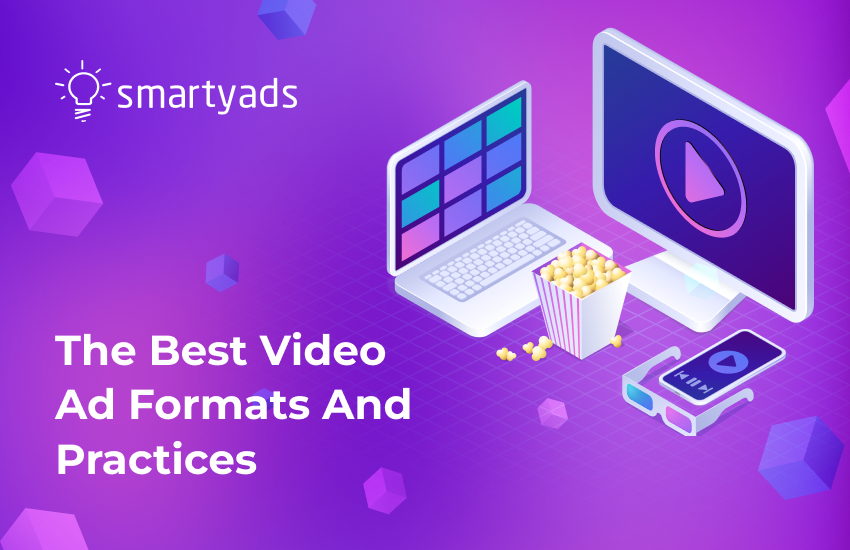Leveraging the potential of digital video advertising has become an incredibly effective approach to capture and involve customers. The era of commercials exclusively on TV screens has passed; today, audiences are flocking to the digital world in pursuit of relatable content.
This paradigm shift has transformed advertising dynamics, with platforms like YouTube, Instagram, Facebook, and TikTok taking center stage as veritable arenas for showcasing products and services through captivating video narratives. As viewers grow more discerning in their content choices, the captivating visuals and storytelling potential of serving video ads offer brands a way to establish meaningful connections.
YouTube's expansive user base and content diversity make it a versatile platform for targeted video campaigns. Instagram's visual focus lets brands craft compelling narratives through Stories and IGTV. Facebook's broad reach and precise targeting enable highly focused video campaigns. TikTok's popularity, especially among younger audiences, offers a chance to create impactful short-form videos.
Why video ad formats are so important?
As per the data compiled by Statista, a staggering count of more than three billion individuals accessed streaming or downloaded videos on the Internet at least once a month in the year 2022.
This figure is anticipated to exhibit an annual growth trajectory, surging towards an impressive tally of nearly 3.5 billion by 2023. Looking specifically at the United States, the year 2020 saw an estimated 244.4 million video enthusiasts engaging in this form of digital content consumption.
During the first quarter of 2023, statistics revealed that online videos managed to capture the attention of an impressive 92% of global Internet users. Notably, the prevailing categories that garnered the highest viewership during this period encompassed music videos, comedic and viral content, informative tutorials, and how-to videos.
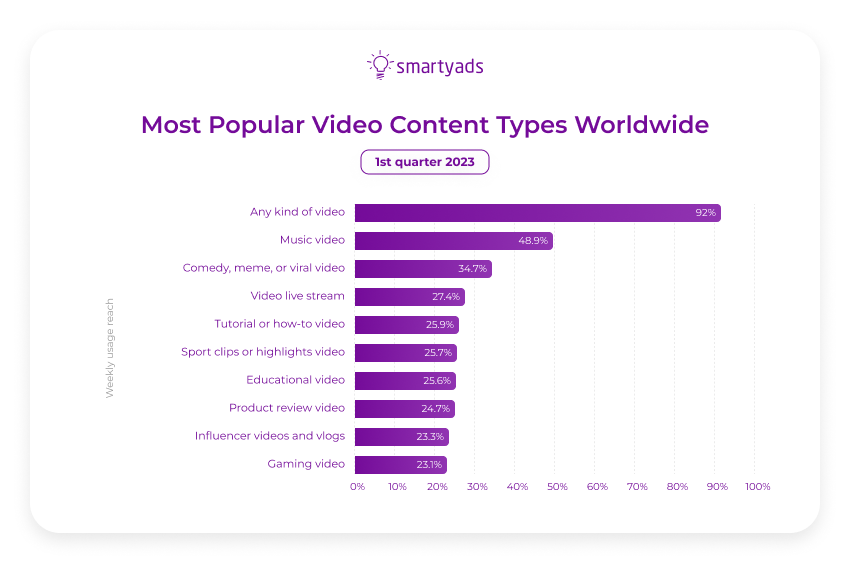
In this evolving advertising landscape, blending creativity with data-driven insights is pivotal for crafting video campaigns that captivate and incite meaningful actions.
By embracing the digital shift and harnessing the multitude of available platforms, businesses can position themselves as leaders in customer engagement, fully unlocking the captivating potential of video advertising.
However, video ad serving is more complicated than banner ad serving, and the choice of different video ad formats is huge. Sometimes, it can be challenging to know what will suit your purpose: whether it will be in-stream video ads, in-feed video ads, in-banner video ads, or even rewarded video ads.
In-Stream Video Ads
In-Stream Video Ads is a video ad format that plays within existing video content. These advertisements are prevalent on platforms like YouTube, streaming services, and social media. They make appearances before (pre-roll), during (mid-roll), or after (post-roll) the core video content, mirroring the format of traditional TV commercials. On occasion, viewers may have the option to skip these ads after a short period.
There is also skippable in-stream video advertising. It may seem disadvantageous to the advertiser, but it has a number of advantages that must also be considered. Skippable in-stream ads respect viewers' choices, allowing them to skip if uninterested, which can lead to a more positive user experience.
This format encourages cost efficiency and heightened engagement when viewers choose not to skip and offers valuable ad metrics. Furthermore, it sparks creative and concise storytelling, potentially reducing viewer resistance to ads. More details on skippable video ad formats will be provided below.
Advantages for Advertisers
High Visibility: In-Stream Video Advertisements are highly conspicuous and seamlessly integrated within the primary video content, ensuring prominent visibility and the potential for increased engagement.
Extensive Audience: Platforms like YouTube feature extensive user communities, providing advertisers access to a diverse and wide-ranging demographic.
Contextual Precision: Advertisers have the option to display their ads on videos closely aligned with their desired audience, heightening contextual appropriateness.
Captivating Narratives: Engaging storytelling within video ads enables advertisers to forge emotional bonds with viewers, effectively conveying their brand message.
Metrics and Analytics: Advertisers can tap into comprehensive metrics, including view count, view-through rate, and engagement data, to gauge the performance of their campaigns.
Disadvantages for Advertisers
Ad Avoidance: Some viewers might skip or ignore In-Stream Video Advertising, especially if they are not engaging or if there's a skip option available.
Ad Blocking: Ad blockers might affect the reach of such ads, limiting their exposure to audiences who have them enabled.
Ad Relevance: If the ad content is not well-aligned with the main video content, viewers might perceive it as disruptive or irrelevant.
Viewability Concerns: On some platforms, the ad might start playing even if it's not in the view of the user, potentially affecting the effectiveness of the ad.
Example of In-Stream ads
Everyone has encountered this form of advertising at least once. These are the ads that might pop up before you start watching a video during dinner or before a movie. It can be a video advertisement for anything. It will work well if it is properly targeted to the right user.
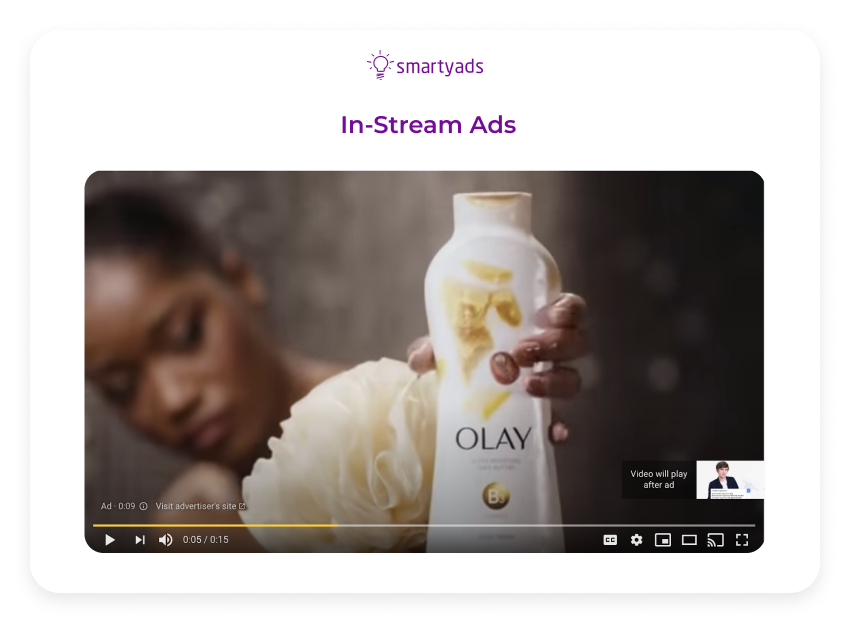
As with any advertising format, the success of In-Stream Video Advertising depends on factors such as ad quality, targeting strategy, relevance to the audience, and the overall viewing experience.
Outstream Video Ads
This is a relatively new format among online video ad units. Outstream Video Ad is one of the video ad formats that automatically plays within the content of a webpage but is not directly connected to the video player.
They often appear between paragraphs of articles or within social media feeds. Outstream Video Ads commence playback when they become visible within the screen's viewable area.
Advantages for Advertisers
Prominent Exposure: Outstream Video Ads enjoy prominent exposure within content, increasing the likelihood of catching viewers' attention.
Extensive Audience: Platforms hosting these ads, like news websites and social media, draw in vast and varied audiences, broadening the ad's outreach.
Contextual Harmony: Advertisers can opt for placements that harmonize contextually with their intended audience, guaranteeing relevance.
Narrative Engagement: Through compelling video content, advertisers can create video ads with an emotional connection with viewers, effectively conveying their brand story.
Detailed Insights: Advertisers can access comprehensive insights, including view counts, engagement metrics, and play rates, to gauge campaign effectiveness.
Disadvantages for Advertisers
Ad Avoidance: Some users might scroll past or disregard Outstream Video Ads, particularly if they find them uninteresting or have the option to scroll quickly.
Cost: Depending on the platform and targeting parameters, producing and distributing Outstream Video Ads can be resource-intensive.
Impact of Ad Blockers: Ad blocker usage could hinder the exposure of Outstream Video Ads, limiting their visibility to users who have ad blockers enabled.
Viewability Concerns: Some platforms may trigger the ad to play even when it's not within the user's immediate view, which can affect its effectiveness.
Example of Outstream video ads
You've probably come across this kind of video ad format before. Usually, such videos can be seen on news portals or information sites. This is also a type of in-feed video ad. You can utilize in-feed video ads to showcase video content in discovery-rich environments. This includes placements adjacent to related YouTube videos, within YouTube search results, or on the YouTube mobile homepage.
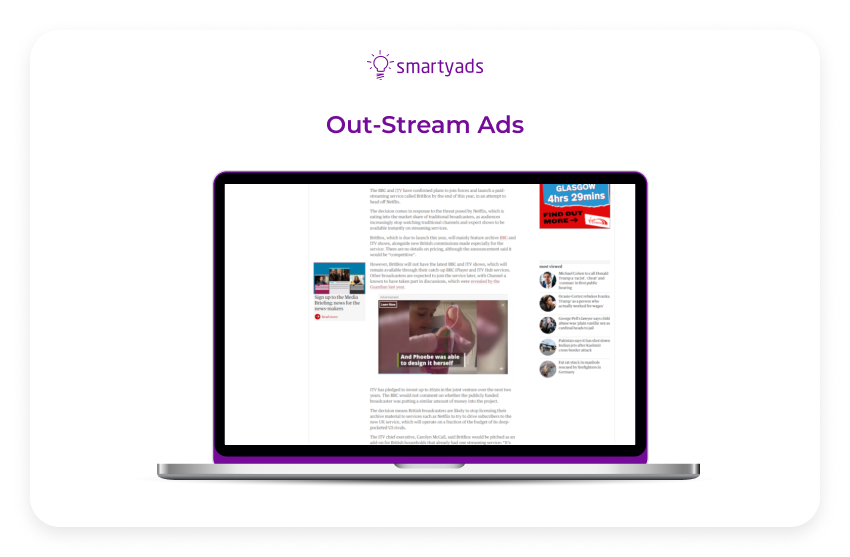
The success of Outstream Video Ads hinges on factors like the quality of the ad, precise targeting, alignment with the audience, and the overall browsing experience.
Skippable In-Stream ads
Skippable In-Stream ads are video advertisements commonly seen on platforms like YouTube. They allow viewers to skip the ad after the initial 5 seconds if it doesn't interest them. Advertisers are typically charged based on viewer engagement or if the viewer watches a significant portion of the ad. These ads aim to strike a balance between delivering content and respecting viewer preferences.
Skippable in-stream ads are video commercials that display before, during, or following other videos on YouTube and across websites and applications associated with Google video partners.
Advantages for Advertisers
Empowered Viewership: Skippable in-stream ads give viewers the freedom to decide whether to engage with the ad or move on to the main content, fostering a more positive user experience.
Selective Engagement: Advertisers can reap the rewards of more engaged viewers, as those who opt not to skip the ad are likely to hold a certain degree of interest.
Flexible Message Delivery: Advertisers have the challenge of capturing attention quickly, which can lead to more creative and impactful ad openings.
Performance Tracking: Advertisers can access data on how many viewers chose to skip the ad versus those who watched it fully, enabling better campaign optimization.
Brand Awareness: Even if viewers skip the ad, there's still potential for brand exposure within those initial seconds, which can contribute to overall awareness.
Disadvantages for Advertisers
Skippability: Some viewers might skip the ad immediately, potentially missing out on the core message that advertisers intended to convey.
Resource Investment: Crafting compelling content within the first few seconds becomes crucial, which can demand additional creative effort.
Risk of Irrelevance: If the ad's opening is not captivating or relevant, viewers might skip early, limiting the ad's impact.
Attention Span Challenge: In a time when attention spans are short, advertisers must swiftly pique interest to discourage skipping.
Competitive Environment: Skippable Video Ads share space with other advertisers, increasing competition for those precious initial seconds.
Example of Skippable in-stream ads
The main secret of skippable video ads is that users will not skip them if the ad is relevant. In other words, with the right targeting, such ads will bring the desired conversions but, at the same time, will not annoy users.
This advertisement from Mailchimp shows the process of attracting customers using their service. Due to the gradual nature of the process, the ad is quite interesting to watch, but at the same time, the users can skip it if they know how such services usually work or are not in the mood to watch this ad.
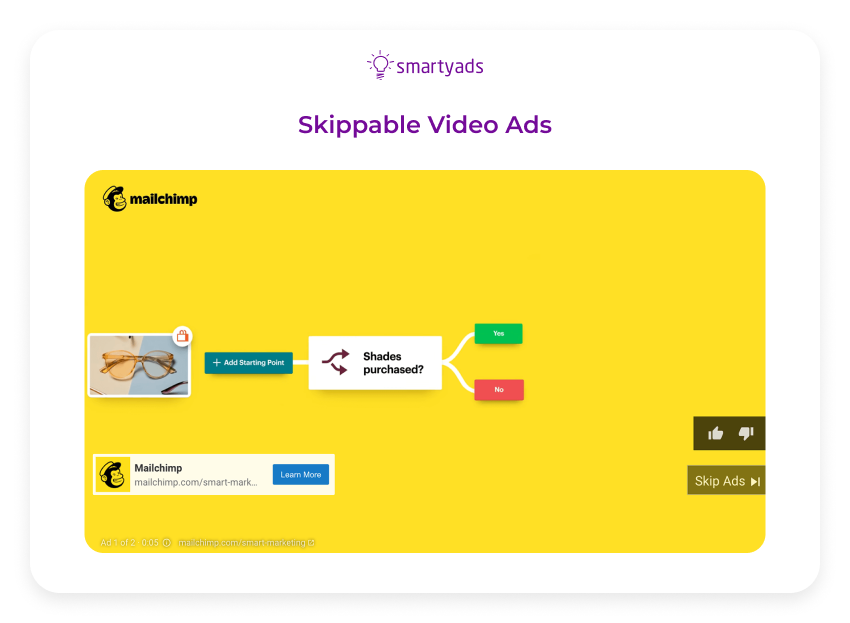
The success of Skippable Video Ads hinges on factors like quick and engaging openings, content relevance, and the ability to make an impression within a short span.
Non-Skippable Video Ads
Non-Skippable Video Ads are video commercials that appear before, during, or after the primary video content and do not allow viewers to skip them. These in-stream ads require viewers to watch the full duration without the option to skip after a designated period.
Advantages for Advertisers
Guaranteed Exposure: Non-Skippable Video Ads ensure that the ad's content is viewed in its entirety, maximizing exposure to the advertised message.
Message Retention: Since viewers cannot skip these ads, there's a higher likelihood that the core message and brand are retained in the viewer's memory.
Complete Creative Freedom: Advertisers enjoy the liberty to shape a narrative or convey a message without being restricted by viewer-initiated skipping.
Strong Influence: Compulsory viewer engagement heightens the likelihood of the ad making a lasting impact and influencing viewers effectively.
Profound Storytelling: Advertisers can leverage the entire ad duration for in-depth storytelling and message delivery.
Disadvantages for Advertisers
Viewer Resistance: The lack of a skip option might lead to viewer resistance, potentially creating negative associations with the brand or the ad itself.
Intrusiveness: Non-Skippable Video Ads can be perceived as intrusive, potentially affecting viewer perception of the content and the brand.
Attention Span: Viewer attention spans are limited, and a mandatory full ad view might lead to disengagement or multitasking.
Ad Avoidance Tactics: Some viewers might resort to using ad blockers to bypass non-skippable ads, reducing their reach.
Example of Non-Skippable In-Stream ads
Every advertiser wants their ads to be seen, so ads that aren't skippable may seem ideal to get users compelled to see them.
Yet, from the user's perspective, intrusive ads can obstruct access to desired content. Even if these ads are pertinent, they often prove vexatious and can tarnish the brand's image. Hence, it is advisable to keep such ads brief, preferably 15 seconds or less.
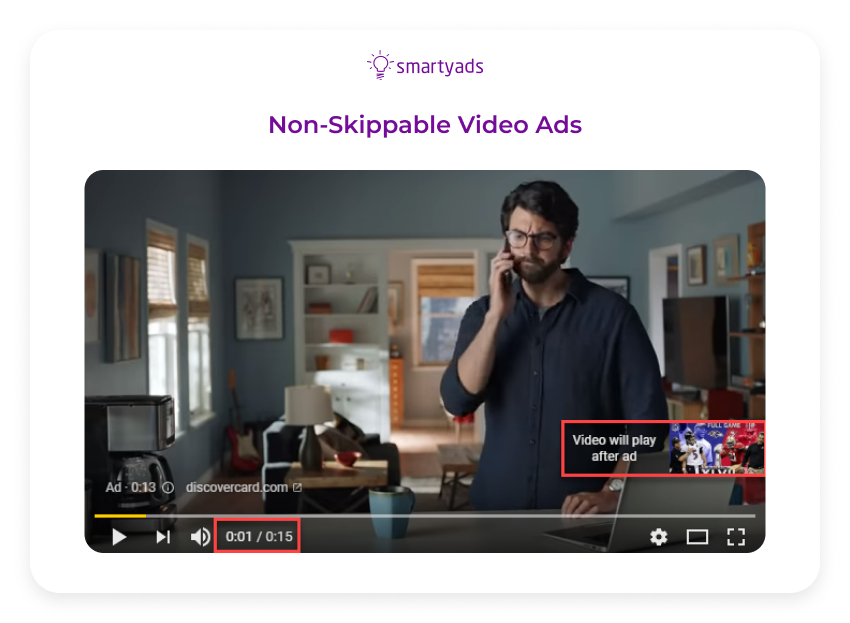
The effectiveness of Non-Skippable Video Ads depends on various factors, including content quality, length, viewer receptivity, and alignment with the overall user experience.
Bumper Video Ads
Bumper Video Ads are ultra-short, non-skippable video ads lasting around 6 seconds. They are designed for quick, memorable messages and are often used for brand awareness or brief promotions.
Advantages for Advertisers
Concise Impact: Bumper Ads offer advertisers a brief yet impactful window to convey their message, ensuring the content is easily digestible.
Instant Attention: Due to their brevity, these ads have the advantage of quickly capturing viewer attention, making an impression in a short amount of time.
Low Viewer Resistance: The short duration reduces the likelihood of viewer resistance, as the ad does not demand a significant time investment.
Versatile Use: Bumper Ads can complement longer ad formats, offering a supplementary touchpoint to reinforce the main message.
Minimal Resource Investment: Crafting a six-second ad requires less creative effort and resources than longer ad formats.
Disadvantages for Advertisers
Limited Message Depth: The short duration constrains the depth of the message and might not allow for intricate storytelling or complex concepts.
Ad Recall Challenge: Given the brief exposure, viewers might remember the ad but not necessarily the brand or key details.
Ad Fatigue: Viewers might tire of seeing repeated short ads, affecting the ad's overall effectiveness over time.
Example of Bumper ads
In the fiercely competitive smartphone market, Samsung faced a formidable challenge. Their Samsung Galaxy S8, boasting its Infinity Plus feature, was promoted through a brief six-second video.
This creative showcase of the product, featuring the Infinity display twice, was accompanied by a compelling "Pre-book Now" call to action. The aim was to make the product shine and maximize its impact within this short timeframe.
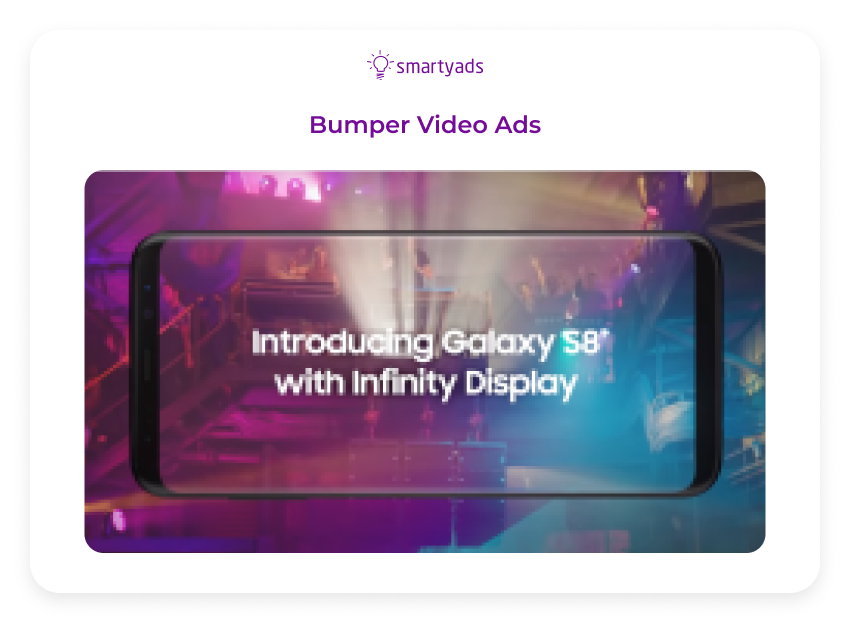
The efficacy of Bumper Ads hinges on concise content creation, impactful visuals, and the ability to make a lasting impression within a short timeframe.
Interactive Video Ads
Interactive video advertising is a format that demands viewer engagement, actively involving them in direct communication with the brand. It enables brands to initiate a conversation with the audience that goes beyond the typical video format. Interactive ads create an immersive "experience" for consumers, enhancing their chances of recalling the ad they interacted with and the brand behind it.
Advantages for Advertisers
Engagement Boost: Interactive Video Ads can significantly increase viewer engagement by inviting active participation rather than passive viewing.
Enhanced Data Collection: Advertisers can gather valuable data on viewer preferences, behaviors, and choices through interactive elements, aiding audience segmentation and targeting.
Stronger Brand Connection: Interactive elements create a more immersive and memorable brand experience, fostering a stronger connection between viewers and the brand.
Extended Ad Exposure: Viewers tend to spend more time with interactive content, potentially extending the ad's exposure and message retention.
Higher Conversion Potential: Interactive elements can drive immediate actions, such as clicks to a website or app downloads, leading to higher conversion rates.
Disadvantages for Advertisers
Ad Blocking: Users employing ad blockers may not have access to interactive elements, reducing the ad's reach.
Measurement Complexity: Measuring the effectiveness of interactive ads can be more intricate, as it involves tracking user interactions and their impact on conversion rates.
Content Overload: Overloading an interactive ad with too many elements can overwhelm viewers and detract from the message's clarity.
Example of Interactive Video Ads
This interactive recruitment video stands out as one of the finest in its category. It skillfully guides viewers through the nuances of Deloitte's etiquette and culture. Its unique approach sets it apart, featuring various scenes that engage viewers interactively.
The "Will You Fit into Deloitte?" video immerses you in different scenarios. In one instance, you find yourself in an elevator with a male colleague, accidentally spilling tea on his suit. How would you handle the situation?
In another scenario, you are tasked with selecting the perfect birthday gift for a fellow colleague. What choice will you make?
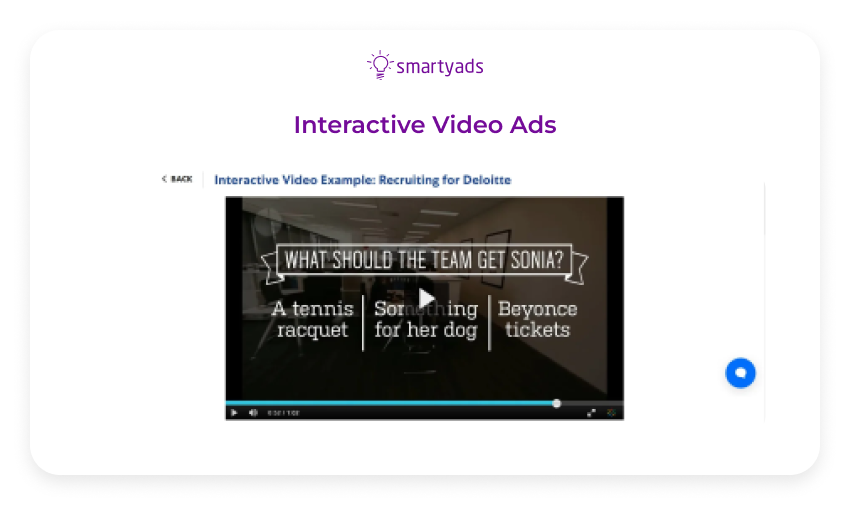
The success of Interactive Video Ads hinges on creative design, seamless functionality, viewer receptivity, and alignment with campaign objectives.
What else?
A robust solution that can seamlessly handle all these ad formats while offering user-friendly templates for ad delivery might be missing from your advertising strategy. So, what's the answer? It's the Demand Side Platform (DSP)!
In essence, a DSP is a versatile tool designed to facilitate the delivery of video ads through VAST, VMAP, or VPAID-compliant video tags. The possibilities for ad units are virtually limitless, particularly when utilizing advanced ad servers like SmartyAds that support custom and non-standard rich media ad formats. While serving video ads can be more complex than traditional banners, worry not. We offer templates that simplify the process and eliminate the need for coding.
Unlock the potential for outstanding ad campaigns with SmartyAds DSP!
